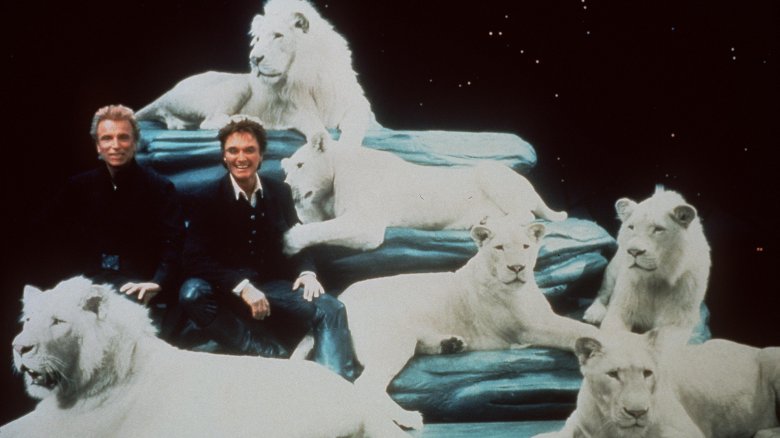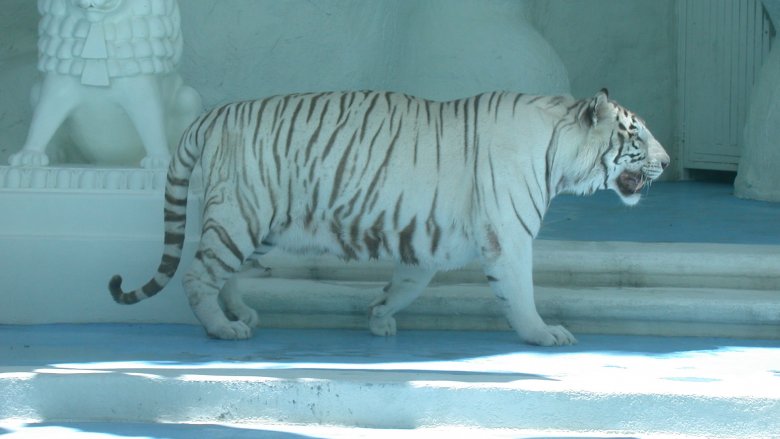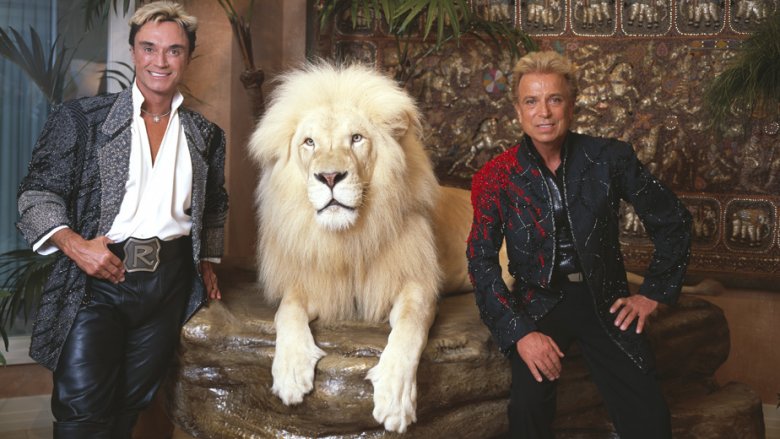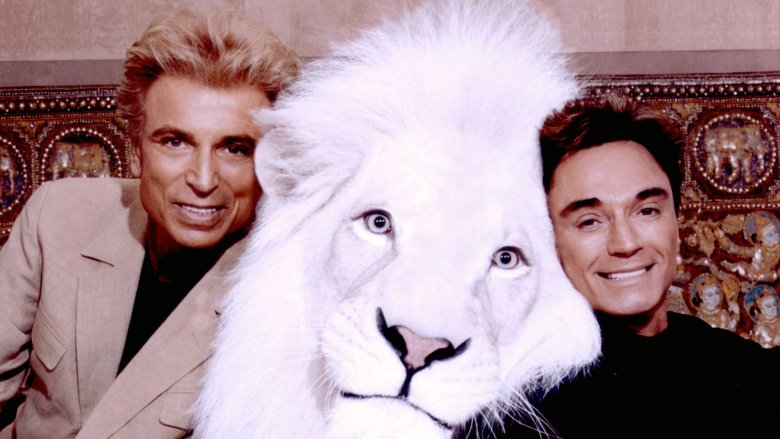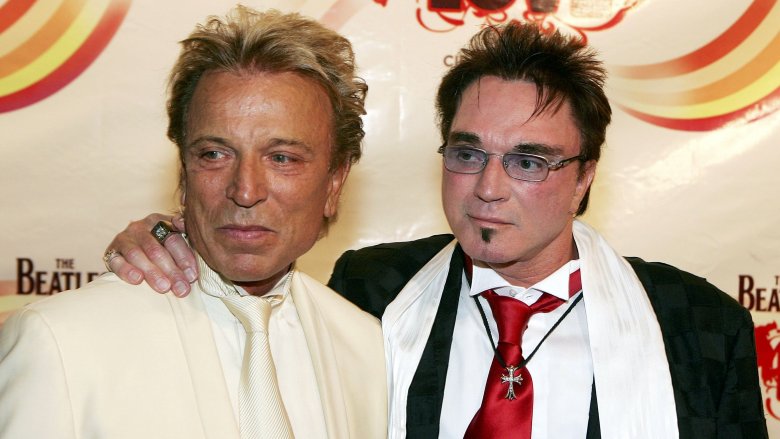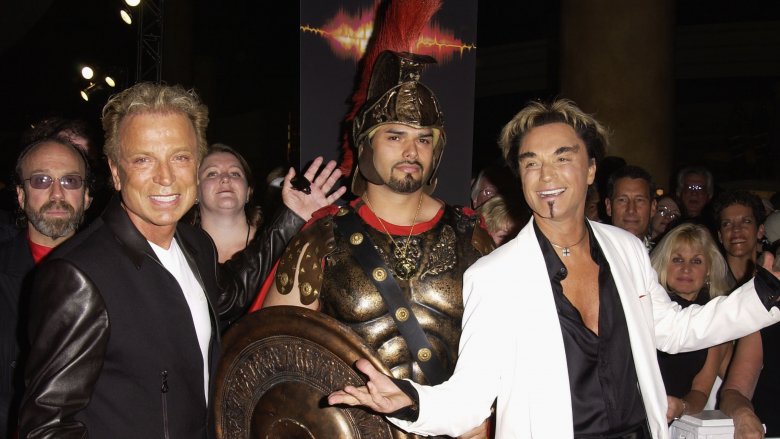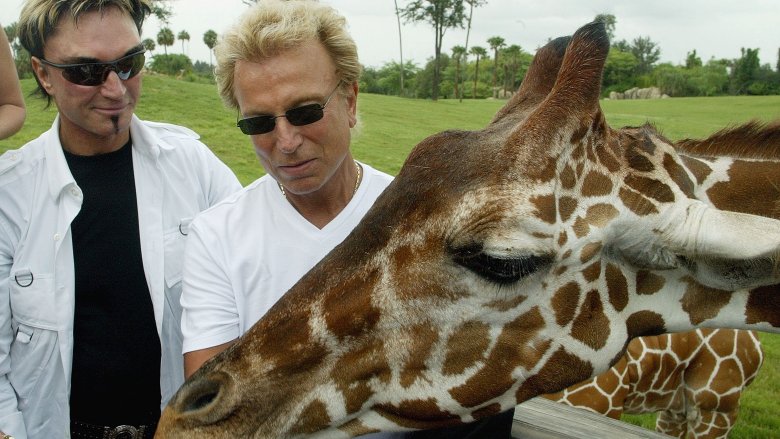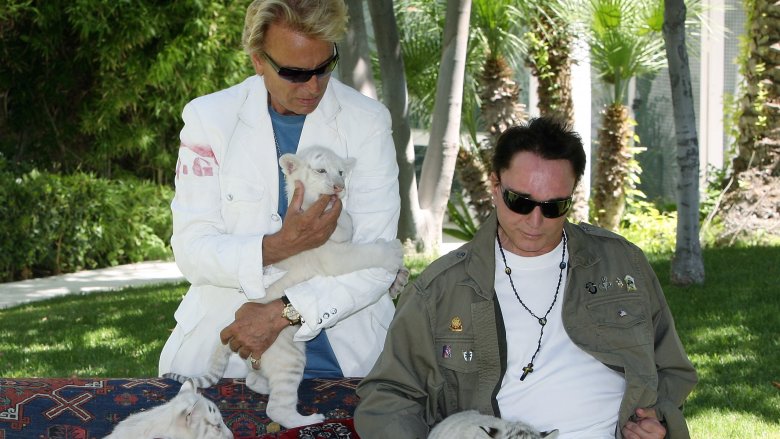The Untold Truth Of Siegfried And Roy
Siegfried and Roy are one of those famous dynamic duos whose names simply must be said together to make any sense, like Batman and Robin, Abbott and Costello, Bonnie and Clyde, Romeo and Juliet. In the 1990s, they took the Las Vegas strip by storm with their magic-meets-tamed-tigers act, raking in the cash and showing the world that you really could mount a money-making family show in the middle of Sin City. Their set at the Mirage ran for thirteen mind-blowing years. Then, in 2003 they made headlines again, but not in the way they wanted. In October of that year, in the middle of a show, Roy suffered a brutal attack at the jaws of Mantacore, a 7-year-old white tiger, and the curtain fell on one of the most flamboyant, exciting, and daring shows in the history of live entertainment.
What many fans might not realize about Siegfried and Roy, born Siegfried Fischbacher and Uwe Ludwig Horn in World War II-era Germany, is that they had a long history together even before they hit the strip with their menagerie of exotic animals. And their story is still being written. Read on for the untold truth of these two charismatic men who overcame bleak childhoods to bring wonder and joy to countless kids the world over.
Both were the children of shell-shocked alcoholics
Siegfried and Roy's fathers fought on the Russian front during World War II, and both returned home broken. In the 2008 biography of the pair, The Secret Life of Siegfried and Roy: How the Tiger Kings Tamed Las Vegas, the authors chronicle the boys' love-starved youths in post-Nazi Germany. Siegfried's father was a prisoner of war and quickly succumbed to alcoholism after peace was declared, and Roy, born in the middle of an air-raid, likewise watched with dread and sadness as his father, another traumatized vet, drank himself out of a family. When Roy's mother married another man, a short period of bliss and prosperity followed, but that man also eventually became a slave to the sauce.
Young Siegfried, depressed and often hungry, taught himself how to do card tricks and other illusions as a way to distract and entertain himself. There was another bonus to Siegfried's talents for sleight-of-hand: performing the tricks was the only way he could command his father's sparse attention. Meanwhile, Roy was happy only when in the company of his dog, Hexe, who was half wolf and saved Roy's life once when Roy, an adventurous kid, found himself stuck in quicksand. Hexe ran off and alerted a nearby farmer, Lassie-style, and Roy was pulled to safety.
The two boys' futures seemed predestined — Siegfried would be a magician and Roy would surround himself with animals, the wilder the better.
A cheetah brought Siegfried and Roy together
Siegfried Fischbacher and Roy Horn met on a cruise ship in 1959. Roy was working as a waiter and Siegfried as a steward. One day, while on break, Roy watched, amused and impressed, while Siegfried performed magic tricks for a few guests and members of staff. Later, Roy approached Siegfried, asking him what would, according to this Best of Vegas article, prove a fateful question: "If you can make a rabbit and a dove disappear and reappear, can you do the same with a cheetah?"
Putting aside whether or not this is the best pickup line ever, it must have struck Siegfried as a bit random, until Roy explained he had a pet cheetah named Chico in his cabin. A life-long animal lover, Roy had managed to smuggle Chico on board the ship in a laundry sack. Siegfried was intrigued; he and Roy began crafting a magic act that would incorporate large animals disappearing and reappearing. They took their act on the road and on the water, entertaining nightclub and cruise crowds around the world.
The compensation wasn't much to write home about until, in the late sixties, they got a standing O from an audience in Monte Carlo. In the audience was a booker with Paris's famed and notoriously naughty Folies Bergere cabaret show. The booker tracked Siegfried and Roy down in Spain and that led to a gig at Las Vegas's Tropicana in 1967. The rest, as they say, is history.
White tigers aren't really a thing
You'd be forgiven for thinking that the white tigers Siegfried and Roy used in their acts came from a specific breed of jungle cat. The truth, according to this look at the cat's checkered history, is that white on a tiger is really an indication of a genetic mutation, and while white tigers are undeniably beautiful, they usually suffer from a number of birth defects, including crossed eyes, club feet, and cleft palettes.
The first white tiger came to the U.S. in the late fifties. Mohini was one of a litter of white tigers born in India and, having been bought by an American businessman, was gifted to Washington D.C.'s National Zoo. Shortly thereafter, Mohini went on a celebrity world tour. Eventually, he landed at the Cincinnati Zoo, where he caught the attention of Siegfried and Roy. The magician friends bought three of Mohini's cubs from the zoo in 1983 and began to breed white tigers for use in their stage act.
Siegfried and Roy popularized white tigers and set the going rate for cubs: $30,000 for white tigers with stripes, $100,000 for white tigers without. But they're not the only Americans keeping tigers in captivity. This Smithsonian Magazine article suggests that the United States has a pretty serious tiger problem. There are now 5,000 captive tigers in America as compared to 3,200 free tigers worldwide, and no one really knows where those tigers are or what sort of lives they lead.
The Siegfried and Roy show was bonkers
Beginning in 1990, Siegfried and Roy entertained roughly 400,000 people a year at their Mirage show, generating $44 million in revenue for the casino's owner, Steve Wynn, and earning pretty nice salaries themselves. The animal-rich extravaganza was, according to Variety, almost always sold out, and, in addition to the trademark white tigers and white lions, the show involved an animatronic dragon, armies of dancers, lots of groovy music, several funny gags, Siegfried and Roy floating through burning hoops of fire, and a Rolls Royce that once belonged to Greta Garbo.
Oh, and did we mention the moment Siegfried would make an entire elephant disappear? Yeah. That happened. The Siegfried and Roy follies were basically Cirque du Soleil before Cirque du Soleil was but a gleam in Canada's eye. One of the show's long-time tiger trainers claimed in this Hollywood Reporter expose that Siegfried and Roy wowed everyone from Michael Jackson — who, incidentally, wrote and performed the show's theme music — to Demi Moore, whose perfume drove one tiger, Jahan, absolutely wild.
The success of the show came as a surprise to many and was quite the coup for two poor boys from Germany's slums who could have never imagined they would one day be performing twice a day to standing-room-only crowds of 1,500 on a stage lit by none other than the crew of Cats. What's the German word for "local boys make very, very good"?
Lions and tigers and dolphins, oh my!
In the course of their four-decade-long careers, Siegfried and Roy have worked with a number of animals, including lions, tigers, elephants, horses, and pot-bellied pigs. In 1990, they added dolphins to their repertoire when Siegfried and Roy's Secret Garden and Dolphin Habitat opened its doors to visitors of the Mirage. Despite the fact that the destination boasts a "focus on scientific research, education, and conservation outreach," it hasn't always been smooth sailing, and animal rights activists suggest that Siegfried and Roy's obsession with animals-as-entertainment might not always be healthy for the animals themselves.
According to the Las Vegas Sun, 15 of the exhibit's dolphins died in the first 20 years of its operation, and two died in 2009 alone. This look at dolphin mortality while in captivity and circumstances at the Mirage in particular suggests that Secret Garden dolphins had a disturbing death rate of 60 percent.
Siegfried and Roy didn't use dolphins in their live shows, so their culpability in the dolphins' deaths is questionable, as is the link between their mortality rate and the habitat itself, and in 2017 the Secret Garden achieved certification by the American Humane Conservation program for animal welfare, becoming the first such facility in the western continental U.S. to do so.
A near-death experience
When the white tiger, Mantacore, was born, he wasn't breathing. According to a story Siegfried and Roy shared with Las Vegas Weekly, Roy cut the tiger's umbilical cord and gave the big cat mouth to mouth. Seven years later, the tiger would attack Roy on stage, ending the show that made Siegfried and Roy household names and nearly killing the man who breathed life into him.
The attack happened on October 3, 2003, Roy Horn's 59th birthday, during what was called "The Rapport" section of the show. A tiger trainer who would go on to accuse Siegfried and Roy of lying about Mantacore's motivation told The Hollywood Reporter that, in that segment, Roy would often dance with his tigers, demonstrating the close bond he and the cats had acquired over years of playing and sleeping and even swimming together. That night, though, something went wrong and, instead of demonstrating affection for Roy, Mantacore sunk his teeth into Roy's neck and dragged him off-stage.
The Today Show detailed Roy's injuries. The attack damaged an artery that carried oxygen to his brain and it crushed his windpipe. He was left partially paralyzed. Insult to injury, the USDA found Siegfried and Roy negligent in the fact the fact that they had no precautions in place to protect the audience should a tiger — or lion or elephant or horse — go rogue and leap into the crowd.
A little white (tiger) lie?
When Roy was gravely injured by Mantacore in 2003, Roy quickly came to the tiger's defense, claiming Mantacore was only trying to help. Roy continues to claim in interviews that he was having a stroke when Mantacore bit him in the neck and dragged him off stage. In Roy's telling, Mantacore was trying, like Roy's beloved dog, Hexe, before him, to get help for Roy, to save his life, but he was a tiger and didn't know better and the effort backfired spectacularly. The USDA's investigation into the attack did not uncover the reason behind Mantacore's out of character behavior and the case seemed closed.
Then, in March 2019, Chris Lawrence, an animal trainer with the show, came forward with his version of events, telling The Hollywood Reporter that Roy's story was a fabrication, cooked up to protect both Mantacore and the Siegfried and Roy brand. Lawrence was onstage when the attack occurred. He tried, to no avail, to drag the cat off Roy, and he now argues that human error — Roy's last-minute decision not to walk the tiger in a circle as planned but corral him with his arm instead — caused the tiger to go into fight mode. Lawrence has also suggested Roy's relationship with Mantacore had deteriorated prior to the attack and that he, Lawrence, suffers from PTSD as a result of witnessing the incident.
Siegfried among the monks
When the white tiger Mantacore attacked Roy Horn mid-show on, ironically, his 59th birthday in 2003, the big cat effectively put an end to the two magician partners doing what they loved best — performing wild and gorgeous and wacky stunts for sold-out crowds in Las Vegas day after day, night after night.
Both men lived for the thrill of live performance. The tiger attack nearly killed them both. In Roy's case, the danger was quite literal, and although some press reports erroneously claimed he died from his wounds, he eventually recovered. Siegfried, though physically unharmed, spiraled. He told a New York Post reporter that he grew depressed and directionless following the shuttering of the show. "The depression was more for the show because it was over, without realizing it," he said. "I went through this crazy time, I went and did a lot of crazy things." Like hiking and backpacking around Europe and hanging out a monastery for a while, all of which must seem pretty crazy to a man used to making white tigers disappear on a regular basis.
Surprise! They're gay!
Siegfried and Roy had been performing a flamboyant magic act with white tigers since the 1980s, but it wasn't until 2007 when they both came out as gay. No one was really surprised. In fact, according to this 2008 biography, it was an open secret in Hollywood and in entertainment circles abroad that they'd been lovers when they first met on a German cruise ship in 1959.
For the purposes of maintaining their successful careers and appealing to families and old ladies — their bread and butter during the Mirage years — they didn't address their sexuality in any way, deciding instead to project a squeaky clean image. Part of that image meant that the dancers in their show, more accustomed to Las Vegas burlesque acts than family entertainment, kept their tops on. At least for the matinees.
Eventually Siegfried and Roy's romantic connection ended and they became best friends, in addition to business partners. Their bond only grew stronger when Roy was attacked by the 400-pound tiger Mantacore in 2003. Siegfried became Roy's caretaker and his champion and he told Barbara Walters in a televised interview that almost losing his soulmate really brought home to him how close the two had become through 44 years of touring and performing together: "Now I realize how important he was in my life."
They bought a zoo
As chronicled in the biography, The Secret Life of Siegfried and Roy: How the Tiger Kings Tamed Las Vegas, Roy Horn grew up surrounded by animals. When he was a boy, his mother's best friend was married to a zookeeper, and Roy, an unhappy, lovelorn boy, spent as much time as he could there. That's how he later came to own a cheetah named Chico who had a starring role in Siegfried and Roy's first magic shows.
Animals were essential to Roy's sense of self and equanimity, so, when Siegfried and Roy started raking in the dough in Las Vegas, they bought a 100-acre estate outside the city and began filling it up with fauna. They called the estate "Little Bavaria" in honor of Siegfried's home, and, according to this Las Vegas Weekly piece, it's now home to scores of horses, black swans, mini-donkeys, African cranes, royal turkeys, and exotic chickens.
The estate also includes a number of fountains and athletic courts and fields. Pathways connect it all, and when Roy was attacked by Mantacore in 2003, Siegfried saw to it that waist-high railings were installed throughout the estate so that Roy could continue to walk its grounds and enjoy his very own zoo.
Siegfried and Roy are really into philanthropy
When Mantacore's attack on Roy Horn ended Siegfried and Roy's onstage careers, they redoubled their efforts in the field of philanthropy. The two magicians had always made giving back a priority — they got their big break during a charity performance in Monte Carlo — and, according to their biographers, their family-friendly shows and desire to help others earned them the nickname "the do-good boys." They delved into do-gooding in a big way first by supporting animals and conservation, and then branched out to supporting local Las Vegas schools and other causes, like the Boys and Girls Club and wounded veterans, not to mention the College of Magic.
Siegfried and Roy's public mindedness is born partially out of their rough-and-tumble backgrounds. Both men had poverty-stricken, lonely childhoods. They know what it's like to go without. Now, with an estimated net worth of $120 million, they can afford to share the wealth, and they do so quite liberally and with an even greater level of gratitude now that they know just how quickly life can be stripped away.
Him too?
In 2011, eight years after being dragged off stage by a 400-pound white tiger, Roy Horn faced another battle — this one in the courts. His personal assistant, Oliver Preiss, accused him of sexual harassment.
According to the Las Vegas Sun, Preiss claimed that Siegfried Fischbacher and Roy Horn regularly importuned him with unwanted attention and that Horn fired him after he rejected his advances. In their defense, Siegfried and Roy accused Preiss of coming to work for them under false pretenses and turning on them in order to enrich himself. In his interviews with the pair, Preiss said he was a skilled physical therapist. In reality, he had no such skills. And he began filming Roy without his permission, eventually sharing video with The National Enquirer, who published the salacious story, "Siegfried and Roy Sex Shocker."
The first judge in the case ordered Press to pay Roy $37,415 for bringing a baseless claim against Horn, but then the plot thickened when three other men joined the suit, claiming that they'd been abused by both Siegfried and Roy while under their employ. The case fell out of the news in 2012. Perhaps it was settled? One thing's for sure: tigers don't talk.
An untimely death
The world-famous duo performed across decades, but on May 9, 2020, CBS News announced that Siegfried and Roy were no more: Roy had passed away the prior day, age 75. The official cause was complications from COVID-19; he had tested positive for the virus in April.
Siegfried gave this heartfelt statement: "The world has lost one of the greats of magic, but I have lost my best friend. From the moment we met, I knew Roy and I, together, would change the world. There could be no Siegfried without Roy, and no Roy without Siegfried. Roy was a fighter his whole life, including during these final days." He continued: "Roy's whole life was about defying the odds. [...] He had a strength and will unlike anyone I have ever known." Even as Siegfried gave his thanks to the medical personnel at Las Vegas's Mountain View Hospital for all they had done to care for Roy and other COVID-19 patients (via The Guardian), he also asked that any memorial donations be made to the Nevada COVID-19 Response, Relief, and Recovery Task Force, or the Cleveland Clinic Lou Ruvo Center for Brain Health.
MGM Resorts, owners of the duo's longtime performance venue The Mirage, also tweeted condolences, saying: "The world lost a legendary figure with the passing of Roy Horn. [...] Our hearts go out to Roy's family and friends, and most notably to Siegfried who shared a lifetime of magic and friendship with this special man."
Siegfried follows shortly after
Just eight months after Roy' Horn's death from complications of COVID-19, it was announced that Siegfried Fischbacher had also died.
According to The Guardian, Siegfried's death was confirmed by his sister, who first spoke with the German news agency dpa to say that he had been at his Las Vegas home — and in the care of Hospice — when he died of pancreatic cancer. The announcement came on Jan. 14, 2021, not long after he underwent a 12-hour surgery to remove a malignant tumor.
Siegfried — who had been born in Bavaria in 1939 and met his lifelong partner in 1957 — was estimated to have performed before some 10 million fans between 1990 and 2001 alone. Siegfried and Roy's act had grossed more than a billion dollars, and the two had been inseparable. After Roy's death, Siegfried told the German paper Bild am Sonntag that he had continued to hold Roy's memory close to his heart. "For dinner, I will continue to have the table set for him, too. Like it always was the case. I'm not alone."
The Las Vegas Review-Journal notes that their last public appearance was in 2009, and in the following years, they continued to be hailed as the act that revolutionized Vegas entertainment, as well as a shining example of living the American dream. According to Siegfried's sister, "He fell asleep gently and peacefully. The death of Siegfried was a redemption."

